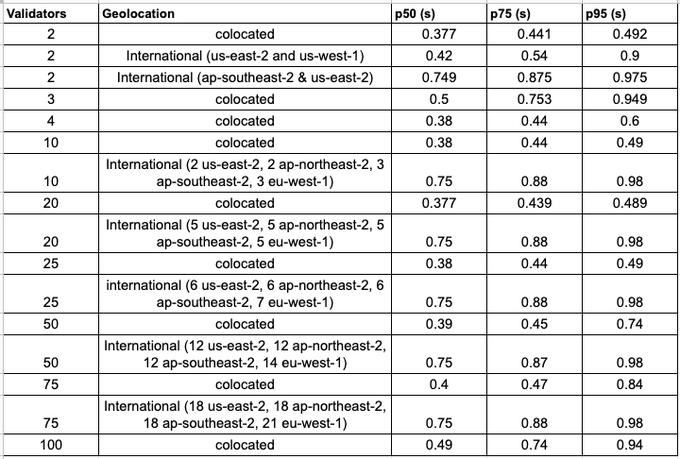
原文地址:https://twitter.com/jayendra_jog/status/1552830894091644929
1/ Latency is one of the most important focus areas for@SeiNetwork.To get a better idea of the lower bound for block times on Sei, we ran the following tests:
延迟是 @SeiNetwork 最重要的关注领域之一。为了更好地了解 Sei 出块时间的下限,我们进行了以下测试:

2/ First takeaway is that the lower bound for p50 latency for a@cosmossdkbased chain is around 390ms, which is ~35% faster than what@solanais seeing in mainnet right now
第一个要点是基于 @cosmossdk 链的 p50 延迟下限约为 390 毫秒,这比 @solana 现在在主网上看到的速度快约 35%
3/ Second takeaway is that geolocation matters — being colocated leads to ~46% better performance than being internationally distributed
第二个要点是地理位置很重要 - 与国际分布相比,同地共处可带来约 46% 的性能提升
4/ Third takeaway is that p50 and p75 latency quickly stabilizes as validator count increases, and generally only p95 latency changes
第三个要点是 p50 和 p75 延迟随着验证者数量的增加而迅速稳定,并且通常只有 p95 延迟发生变化
5/ One other interesting note -- 3 validators perform worse than 4 because all of them need to vote, whereas with 4, only 3/4 are needed for consensus
另一个有趣的注意事项——3 个验证者的表现比 4 个差,因为他们都需要投票,而 4 个验证者只需要 3/4 来达成共识
6/ These loads tests were run on AWS, with all of the colocated tests in the same region (but not necessarily in the same availability zones). Since we were trying to identify the lower bound, there was no traffic (0 transactions per block)
这些负载测试在 AWS 上运行,所有托管测试都在同一区域(但不一定在同一可用区)。由于我们试图确定下限,因此没有流量(每块 0 笔交易)
7/ We were also using machines with the following specs — 8 core CPU, 32GB RAM, and 100GB NVME storage. Voting power was evenly distributed between all validators @philipsu522for running these
我们还使用了具有以下规格的机器——8 核 CPU、32GB RAM 和 100GB NVME 存储。投票权在所有验证者之间平均分配 @philipsu522 用于运行.

